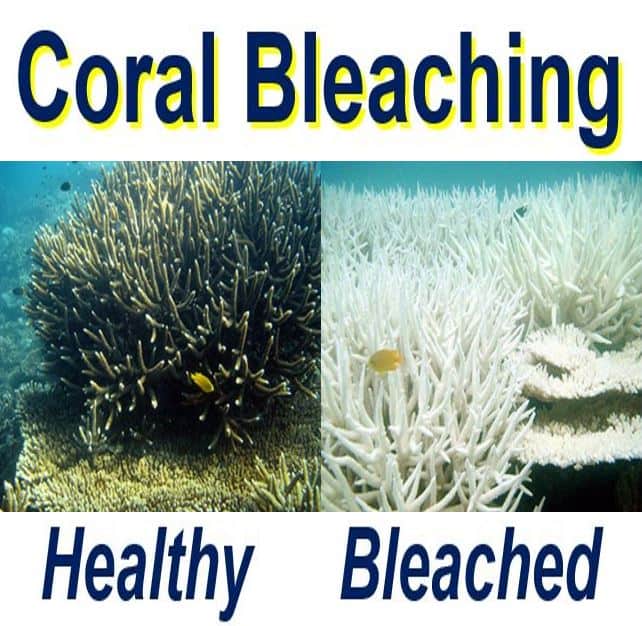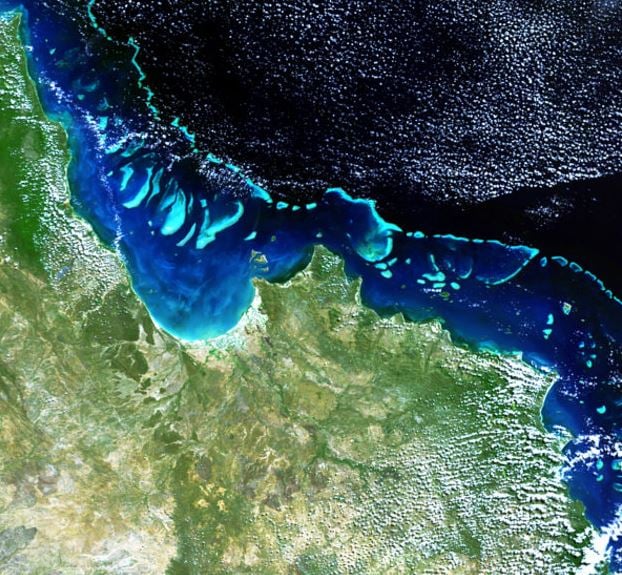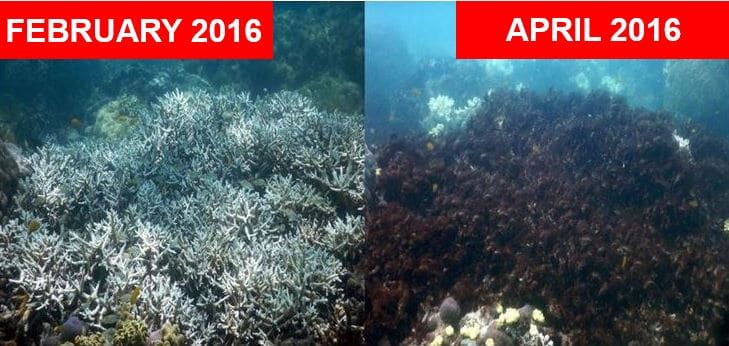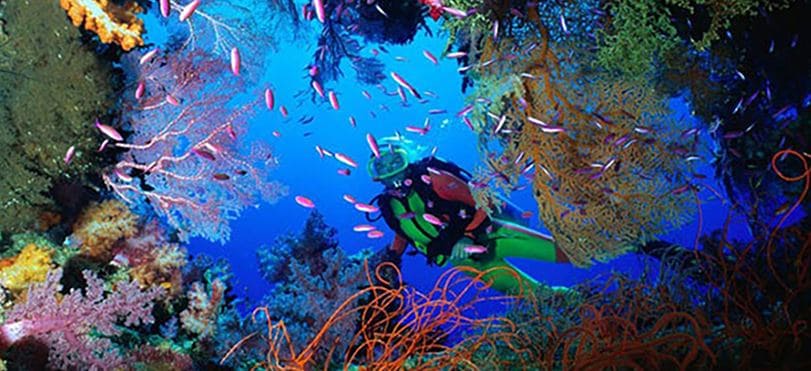Saving the Great Barrier Reef will cost an estimated AU$16 billion, according to a secret Queensland Government modelling document. The money would have to be spent over a period of ten years to restore water quality and halt the mass bleaching that has destroyed thirty-five percent of the corals on the northern and central sections of the world’s largest reef.
The secret document, obtained by ABC News, a division of the Australian Broadcasting Corporation (ABC), makes the amount of money that Australia’s main parties have set aside for fighting pollution on the reef seem like nothing.
ABC News’ reporter Mark Willacy quoted Queensland’s Chief Scientist Geoff Garrett, who said:
“If we carry on as we are, with poor water quality, we are stuffed with a capital ‘S’ underlined bold.”
 The first stage of deterioration after water temperatures rise abnormally is coral bleaching. If temperatures do not return to normal, the coral eventually dies. (Image: ucar.edu)
The first stage of deterioration after water temperatures rise abnormally is coral bleaching. If temperatures do not return to normal, the coral eventually dies. (Image: ucar.edu)
Water quality threat to corals
The greatest threats to the corals come from the quality of the seawater around them, which has seen rising concentrations of pesticides, excess nutrients (nitrogen) and fine sediments.
The water temperatures in the central and northern sections of the Reef have risen abnormally, and triggered mass bleaching, which eventually kills off the corals if the sea does not rapidly cool down again.
A Taskforce has put forward a series of urgent measures to address the water pollution, including capping sediment and fertiliser run-off flowing from several rivers into the marine park.
However, for any of these measures to have a chance of achieving effective results, the Taskforce warned that considerably more investment was needed.
 This Envisat photo (taken from space) shows part of the 2300-kilometre-long Great Barrier Reef off Australia’s Queensland coast, just beneath the sea surface. It is an interlinked system of about 3000 reefs and 900 coral islands, divided by narrow passages. It has an area of diversity equal in importance to tropical rainforests. (Image: esa.int)
This Envisat photo (taken from space) shows part of the 2300-kilometre-long Great Barrier Reef off Australia’s Queensland coast, just beneath the sea surface. It is an interlinked system of about 3000 reefs and 900 coral islands, divided by narrow passages. It has an area of diversity equal in importance to tropical rainforests. (Image: esa.int)
Reef spokesman for the World Wildlife Fund, Nick Heath, said that for a period of many years, politicians from all the main parties have ducked asking the questions that really matter regarding saving the corals, because they clearly do not want to know the answer.
Mr. Heath explained that while governments have spent AU$13 billion on fixing the Murray-Darling Basin, a worthy cause, “they’ve spent nowhere near that amount of money on the Great Barrier Reef.”
Great Barrier Reef is dying
After several underwater and aerial surveys over a period of months, scientists released an initial estimate on the death toll resulting from mass coral bleaching.
When sea temperatures rise, corals expel a small photosynthetic algae called zooxanthellae. When zooxanthellae concentrations go below a certain level, the corals turn white – they bleach.
If sea temperatures return to normal in time, the zooxanthellae are able to recolonize the corals, and there is a chance that they make a full recovery – otherwise they die.
In this latest report, scientists say the impact of coral bleaching on the whole reef is still unfolding. The northern sections have been severely affected, unlike the southern sections, which have been spared serious damage.
 A depressing story. In February this year, the mature staghorn coral at Lizard Island was bleached. Within just two months it was dead. This is just a snapshot of what has happened to 35% of all the corals in the northern and central sections of the Great Barrier Reef. (Image: coralcoe.org.au)
A depressing story. In February this year, the mature staghorn coral at Lizard Island was bleached. Within just two months it was dead. This is just a snapshot of what has happened to 35% of all the corals in the northern and central sections of the Great Barrier Reef. (Image: coralcoe.org.au)
Director of the ARC Centre of Excellence for Coral Reef Studies at James Cook University (JCU) in Queensland, Prof. Terry Hughes, said:
“We found on average, that 35% of the corals are now dead or dying on 84 reefs that we surveyed along the northern and central sections of the Great Barrier Reef, between Townsville and Papua New Guinea. Some reefs are in much better shape, especially from Cairns southwards, where the average mortality is estimated at only 5%.”
“This year is the third time in 18 years that the Great Barrier Reef has experienced mass bleaching due to global warming, and the current event is much more extreme than we’ve measured before.”
“These three events have all occurred while global temperatures have risen by just 1 degree C above the pre-industrial period. We’re rapidly running out of time to reduce greenhouse gas emissions.”
While 35% of the corals in the north have died, only 5% in the south have perished, says Dr. Mia Hoogenboom, also from JCU. Experts say that in the south the mildly-bleached corals should get their normal colours back within the next few months.
Even though fewer southern corals have died, the stress from bleaching will temporarily slow their growth and reproduction rates, say marine biologists.
 The waters around the Great Barrier Reef are a haven for marine wildlife. Thirty species of whales, porpoises and dolphins; over 1,500 fish species; 17 species of sea snake; 6 species of sea turtles; 15 species of seagress; saltwater crocodiles live in mangroves and salt marshes nearby; 125 species of shark, skates, stingray or chimaera; nearly 5,000 species of mollusc; 49 species of pipefish; 9 species of seahorse; and at least 7 species of frog. (Image: cairnstours.net.au)
The waters around the Great Barrier Reef are a haven for marine wildlife. Thirty species of whales, porpoises and dolphins; over 1,500 fish species; 17 species of sea snake; 6 species of sea turtles; 15 species of seagress; saltwater crocodiles live in mangroves and salt marshes nearby; 125 species of shark, skates, stingray or chimaera; nearly 5,000 species of mollusc; 49 species of pipefish; 9 species of seahorse; and at least 7 species of frog. (Image: cairnstours.net.au)
Fortunately, sea temperatures in the south did not veer much from normal, unlike the northern section, where abnormal warming occurred.
Great Barrier Reef has lost its resilience
Professor John Pandolfi, who works at the ARC Centre of Excellence for Coral Reef Studies at The University of Queensland, said:
“It is critically important now to bolster the resilience of the Reef, and to maximise its natural capacity to recover. But the reef is no longer as resilient as it once was, and it’s struggling to cope with three bleaching events in just 18 years.”
Dr. Verena Schoepf, a Research Associate at the University of Western Australia’s School of Earth and Environment, said:
“On the Kimberley coast where I work, up to 80% of the corals are severely bleached, and at least 15% have died already.”
Reef provides income and jobs
According to government data, Reef Tourism brings in about AU$5 billion annually in income, and directly employs nearly 70,000 workers.
Chief Executive of the Queensland Tourism Industry Council, Daniel Gschwind, explained:
“Thankfully, many parts of the reef are still in excellent shape, but we can’t just ignore coral bleaching and hope for a swift recovery. Short-term development policies have to be weighed up against long-term environmental damage, including impacts on the reef from climate change.”
Video – Great Barrier Reef mass bleaching
More than one third of the northern and central parts of the Great Barrier Reef has died because of mass bleaching.

